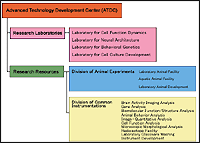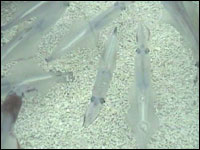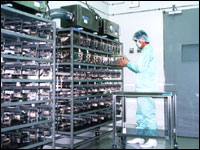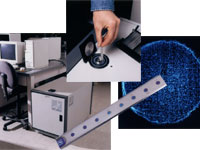 |

Organization chart of Advanced Technology Development Center
magnified scene by clicking image
|
Scientists are well acquainted with these procedures, and namely, scientific discoveries owe much to selected research technologies and materials by themselves. In particular, strategic methodologies from a broad range of scientific fields are necessary for investigating the brain science because the brain is composed of billions of neurons with extremely complex networks as well as vast quantities of information.
The ATDC was launched to enhance the technological standards in BSI. The current constitution (refer to the Organization chart) and future plans will be introduced here.
|
 |
 |
What Is Research Resources (RR)?
The RR is a supporting system for scientific technologies in BSI, consisting of two divisions as shown in the Organization chart. Mice, rats, rabbits, cats and monkeys are reared in the Laboratory Animal Facility, while squids, zebrafish, newts and African clawed frogs are raised in the Aquatic Animal Facility. In recent years, studies at the genetic level have been highlighted and actively conducted even in brain science. For example, numerous genes related to the generation and differentiation of the brain, mental functions such as recognition, memory and thought, and also related to many neurological diseases have been discovered. Experimental studies using the laboratory animals are indispensable in analyzing the role of such genes.
In the Animal Facility, animals are cared for by experts, and the establishment of equipment to rear them meets international standards. Thus, the Animal Facility supplies reliable high quality laboratory animals. Other activities in this Facility include mutant animal generation, production of germ-free animals, pathological and microbiological analysis of animals, and cryopreservation of embryos and gametes. Precise behavioral observation and genetical analysis of animals will be carried out in the near future.
In the division of Common Instrumentations many relevant instruments under the items shown in the Organization chart have been installed with expert operators. Since the use of advanced instruments as one of means of research is very important, RR steadily provides new analytical instruments by surveying requests from researchers.
|
 |
|
These two divisions are organized so that the researchers can make use of them freely and efficiently. What is of importance in the management of RR is the constant innovation of technologies. To meet this requirement, the animal care staff and the instrument operators keep in close touch with both of experts and the researchers so that they can acquire new technologies while conducting the activities. In addition, we send the staff to various training courses related to technologies so that they can learn these new technologies. I think it is essential to establish a system in which the staff can act positively with confidence and pride.
Another Research Resources
Individual researchers have their own special research methodologies. The ATDC surveys them periodically and circulates them through a home page. Thus, BSI researchers can exchange their technologies in give-and-take style. I think the following correspondence is one outcome of this system: By e-mail, messages asking "Is there anybody who has this kind of antibody?" or "Would anybody kindly teach me about such technology?" are sent, then, responding e-mails are returned, saying "I have it." or "I will teach you." I consider such list-up and exchange systems of the methodologies as another type of RR. At any rate, this system is beneficial for researchers and will help to enhance technological standards as well as collaboration works in BSI.
What Is the Goal of the ATDC?
We are going to expand common instrumentations and will provide more useful services for researchers. It is expected that innovative and strategic technologies and materials related to brain science will be created in BSI as well as in the ATDC. These will contribute to the study of life sciences in the coming 21st century. Finally, I hope that all of our facilities and technologies in our Institute will be open to outside researchers in the near future.
|

Squids in the water tank of Aquatic Animal Facility. They have the habit of "homing". Squids are used for studies at the genetic level how such information is taken into them.
|

Micro-barrier mouse housing system in which sterile air and water are supplied. Mutant mice are reared by this system.
|

An istrument consisting of mass spectrometer and protein chip array. It has been newly developed to analyze the protein expression, function and so on.
magnified scene by clicking image
|
 |
 |
|
|






